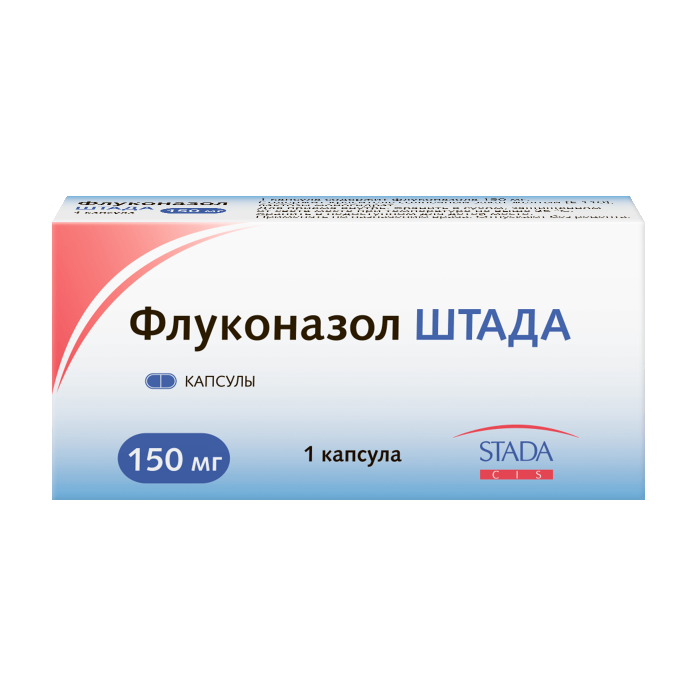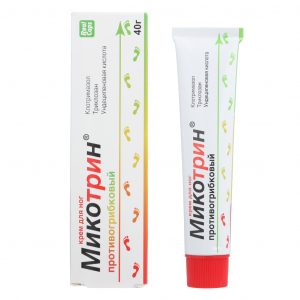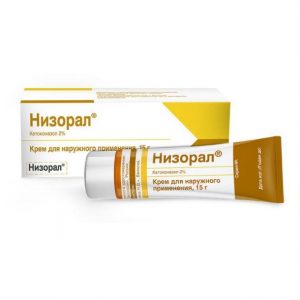Description
16 ka
Capsules
Packing
1 caps.
Pharmacological action
Antifungal agent, has a highly specific effect, inhibiting the activity of fungal enzymes dependent on cytochrome P450. It blocks the conversion of lanosterol of fungal cells into a membrane lipid – ergosterol increases the permeability of the cell membrane, disrupts its growth and replication.
Fluconazole, being highly selective for cytochrome P450 fungi, practically does not inhibit these enzymes in the human body (in comparison with itraconazole, clotrimazole, econazole and ketoconazole, it inhibits cytochrome P450-dependent oxidative processes in human liver microsomes to a lesser extent). It does not have antiadrogenic activity.
Active in opportunistic mycoses, incl. caused by Candida spp. (including generalized forms of candidiasis against the background of immunosuppression), Cryptococcus neoformans and Coccidioides immitis (including intracranial infections), Microsporum spp. and Trichophyton spp. with endemic mycoses caused by Blastomyces dermatidis, Histoplasma capsulatum (including immunosuppression).
Pharmacokinetics
After oral administration, fluconazole is well absorbed, food intake does not affect the rate of absorption of fluconazole, its bioavailability is 90%.
The time to reach the maximum concentration after ingestion of 150 mg of the drug on an empty stomach is 0.5-1.5 hours, Cmax is 90% of the concentration in plasma with iv administration at a dose of 2.5-3.5 mg / L. 2 fluconazole is 30 hours. Communication with plasma proteins – 11-12%. Plasma concentration is directly dependent on the dose. 90% level of equilibrium concentration is reached by the 4th 5th day of treatment with the drug (when taken once a day).
The introduction of a loading dose (on the first day), 2 times the normal daily, allows you to reach a concentration level corresponding to 90% of the equilibrium concentration by the second day.
Fluconazole penetrates well into all body fluids. The concentration of the active substance in breast milk, articular fluid, saliva, sputum and peritoneal fluid is similar to its plasma levels. Constant values in the vaginal secretion are reached 8 hours after ingestion and are kept at this level for at least 24 hours. Fluconazole penetrates well into the cerebrospinal fluid (CSF) – with fungal meningitis, the concentration in CSF is about 85% of its plasma level. In sweat fluid epidermis and stratum corneum (selective accumulation) concentrations exceeding serum are achieved. After oral administration of 150 mg on the 7th day, the concentration in the stratum corneum of the skin is 23.4 μg / g, and 1 week after taking the second dose – 7.1 μg / g the concentration in the nails after 4 months of use at a dose of 150 mg 1 once a week – 4.05 mcg / g in healthy and 1.8 mcg / g in affected nails. The volume of distribution approaches the total water content in the body.
Is an inhibitor of the CYP2C9 isoenzyme in the liver. It is excreted mainly by the kidneys (80% – unchanged, 11% – in the form of metabolites). Fluconazole clearance is proportional to creatinine clearance. No metabolites of fluconazole were found in peripheral blood.
The pharmacokinetics of fluconazole substantially depends on the functional state of the kidneys, however, there is an inverse relationship between the elimination half-life and creatinine clearance. After hemodialysis for 3 hours, the concentration of fluconazole in the plasma is reduced by 50%.
Indications
cryptococcosis, including cryptococcal meningitis and other localizations of this infection (including lungs, skin), both in patients with a normal immune response and in patients with various forms of immunosuppression (including in patients with AIDS , for organ transplantation), the drug can be used to prevent cryptococcal infection in AIDS patients with
generalized candidiasis, including candidaemia, disseminated candidiasis and other forms of invasive candida infections (infections of the peritoneum, endocardium, eyes, respiratory and urinary tracts). Treatment can be carried out in patients with malignant neoplasms, patients in the intensive care unit, patients undergoing a course of cytostatic or immunosuppressive therapy, as well as in the presence of other factors predisposing to the development of candidiasis
candidiasis of the mucous membranes, including the oral cavity and pharynx (including atrophic candidiasis of the oral cavity associated with wearing dentures), the esophagus, non-invasive bronchopulmonary candidiasis, candiduria, skin candidiasis prevention of relapse of oropharyngeal candidiasis in AIDS patients with
genital candidiasis: vaginal candidiasis (acute and chronic recurrent), prophylactic use to reduce the frequency of relapse of vaginal candidiasis (3 or more episodes per year) candidal balanitis
prevention of fungal infections in patients with malignant neoplasms who are predisposed to such infections as a result of chemotherapy with cytostatics or radiation therapy
mycoses of the skin, including mycoses of the feet, body, groin in the new area, pityriasis versicolor, onychomycosis, candidiasis of the skin
deep endemic mycoses, including coccidioidomycosis, paracoccidiomycosis, sporotrichosis and histoplasmosis in patients with normal immunity.
Contraindications
hypersensitivity to the drug (including a history of other azole antifungal drugs)
simultaneous administration of terfenadine (against the background of continuous administration of fluconazole at a dose of 400 mg / day or more) or astemizole, as well as other interval drugs, QT
children under 4 years old.
Precautions: liver and / or renal failure, rash on the background of fluconazole in patients with superficial fungal infection and invasive / systemic fungal infections, concomitant use of terfenadine and fluconazole in a dose of less than 400 mg / day, concomitant use of potentially hepatotoxic drugs, alcoholism potentially proarrhythmogenic conditions in patients with multiple risk factors (organic heart disease, electrolyte imbalance, concomitant use of drugs that cause arrhythmias), pregnancy
Use during pregnancy and lactation
Pregnancy is not advisable in pregnant women, with the exception of severe or life-threatening forms of fungal infections, when the potential benefits of fluconazole for the mother significantly exceed the risk to the fetus.
Since the concentration of fluconazole in breast milk and plasma is the same, it is contraindicated to use the drug during lactation.
Composition
1 capsule contains: active substance: fluconazole 150 mg
excipients: lactose, potato starch, croscarmellose sodium (primellose), povidone (low molecular weight polyvinylpyrrolidone medical), magnesium stearate, talc
capsules No. 1: gelatin, titanium dioxide, yellow colorant, yellow dye [E110]
Side effects of the
From the digestive system: decreased appetite, taste changes, abdominal pain, vomiting, nausea, diarrhea, flatulence, rarely – impaired liver function (jaundice, hepatitis, hepatonecrosis, hyperbilirubinemia, increased activity of alanine aminotransferase, alkaline phosphatase, hepatocellular necrosis), including heavy.
From the nervous system: headache, dizziness, excessive fatigue, rarely – cramps.
From the hemopoietic organs: rarely – leukopenia, thrombocytopenia (bleeding, petechiae), neutropenia, agranulocytosis.
Allergic reactions: skin rash, rarely erythema multiforme exudative (including Stevens-Johnson syndrome), toxic epidermal necrolysis (Lyell’s syndrome), anaphylactoid reactions (including angioedema, swelling of the face, urticaria, itching of the skin).
From the cardiovascular system: an increase in the duration of the QT interval, ventricular fibrillation / flutter.
Other: rarely – impaired renal function, alopecia, hypercholesterolemia, hypertriglyceridemia, hypokalemia.
Drug Interaction
Increases PV by an average of 12% when fluconazole is used with warfarin. In this regard, it is recommended to carefully monitor the parameters of PV in patients receiving the drug in combination with coumarin anticoagulants.
Fluconazole increases the plasma half-life of oral hypoglycemic agents – sulfonylureas (chlorpropamide, glibenclamide, glipizide, tolbutamide) in healthy people. Co-administration of fluconazole and oral hypoglycemic agents in patients with diabetes is permitted, but the physician should keep in mind the possibility of developing hypoglycemia.
Concomitant administration of Fluconazole and phenytoin may increase the plasma phenytoin concentration to a clinically relevant level. Therefore, if necessary, the co-administration of these drugs should monitor the concentration of phenytoin with dose adjustment in order to maintain the drug level within the therapeutic interval.
Combination with rifampicin results in a 25% decrease in AUC and a 20% reduction in the plasma half-life of fluconazole. Therefore, it is advisable to increase the dose of Fluconazole in patients receiving concomitant rifampicin.
It is recommended that blood levels of cyclosporine be monitored in patients receiving fluconazole, as they should be controlled. the use of fluconazole and cyclosporine in patients with a transplanted kidney (administration of Fluconazole at a dose of 200 mg / day) leads to a slow increase in the concentration of cyclosporine in plasma.
Patients receiving high doses of theophylline or who are likely to develop theophylline intoxication should be monitored for early detection of symptoms of theophylline overdose. fluconazole administration results in a decrease in the average clearance rate of theophylline from plasma.
When fluconazole is co-administered with terfenadine and cisapride, cardiac adverse events, including ventricular tachycardia (torsades de points), have been reported.
Concomitant administration of fluconazole and hydrochlorothiazide may increase plasma concentrations of fluconazole by 40%.
Fluconazole and rifabutin have been reported to be associated with increased serum levels of the latter. When fluconazole and rifabutin are co-administered, cases of uveitis have been reported. Patients receiving rifabutin and fluconazole should be closely monitored.
In patients receiving a combination of fluconazole and zidovudine, an increase in zidovudine is observed, which is caused by a decrease in the latter’s metabolism into its major metabolite, therefore, an increase in the side effects of zidovudine should be expected.
Increases the concentration of midazolam, which raises the risk of developing psychomotor effects (most pronounced when using fluconazole orally, rather than IV).
Increases tacrolimus concentration, thereby increasing the risk of nephrotoxicity.
Overdose
Symptoms: hallucinations, paranoid behavior.
Treatment: symptomatic – gastric lavage, forced diuresis. Hemodialysis reduces plasma concentrations by about 50% for 3 hours.
Storage conditions
In a dry, dark place at a temperature of 15 25 ° C.
Expiration
2 Year
Active ingredient
Fluconazole
Pharmacy terms
Over-the-counter
dosage form
dosage form
capsules




